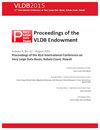金牛座MM:把Multi-Master带到云端
IF 3.3
3区 计算机科学
Q2 COMPUTER SCIENCE, INFORMATION SYSTEMS
引用次数: 0
摘要
单主数据库的更新能力有限,因为一个节点处理所有更新。多主数据库可能具有更高的更新能力,因为负载分布在多个节点上。然而,协调更新和确保持久性的需求可能会产生高网络流量。在网络基础设施由数千个租户共享的云环境中,减少网络负载尤为重要。在本文中,我们提出了Taurus MM,一个针对云环境优化的共享存储多主数据库。它实现了两种新颖的算法,旨在减少网络流量以及一些额外的优化。第一种算法是一种新型的分布式时钟,它结合了Lamport时钟的小尺寸和矢量时钟的分布式快照的有效支持。第二种算法是一种新的页和行混合锁协议,它显著减少了通过网络发送的锁请求的数量。在多达8个master的集群上的实验结果表明,与Aurora multi-master和CockroachDB相比,性能更优越。本文章由计算机程序翻译,如有差异,请以英文原文为准。
Taurus MM: Bringing Multi-Master to the Cloud
A single-master database has limited update capacity because a single node handles all updates. A multi-master database potentially has higher update capacity because the load is spread across multiple nodes. However, the need to coordinate updates and ensure durability can generate high network traffic. Reducing network load is particularly important in a cloud environment where the network infrastructure is shared among thousands of tenants. In this paper, we present Taurus MM, a shared-storage multi-master database optimized for cloud environments. It implements two novel algorithms aimed at reducing network traffic plus a number of additional optimizations. The first algorithm is a new type of distributed clock that combines the small size of Lamport clocks with the effective support of distributed snapshots of vector clocks. The second algorithm is a new hybrid page and row locking protocol that significantly reduces the number of lock requests sent over the network. Experimental results on a cluster with up to eight masters demonstrate superior performance compared to Aurora multi-master and CockroachDB.
求助全文
通过发布文献求助,成功后即可免费获取论文全文。
去求助
来源期刊

Proceedings of the Vldb Endowment
Computer Science-General Computer Science
CiteScore
7.70
自引率
0.00%
发文量
95
期刊介绍:
The Proceedings of the VLDB (PVLDB) welcomes original research papers on a broad range of research topics related to all aspects of data management, where systems issues play a significant role, such as data management system technology and information management infrastructures, including their very large scale of experimentation, novel architectures, and demanding applications as well as their underpinning theory. The scope of a submission for PVLDB is also described by the subject areas given below. Moreover, the scope of PVLDB is restricted to scientific areas that are covered by the combined expertise on the submission’s topic of the journal’s editorial board. Finally, the submission’s contributions should build on work already published in data management outlets, e.g., PVLDB, VLDBJ, ACM SIGMOD, IEEE ICDE, EDBT, ACM TODS, IEEE TKDE, and go beyond a syntactic citation.
 求助内容:
求助内容: 应助结果提醒方式:
应助结果提醒方式:


